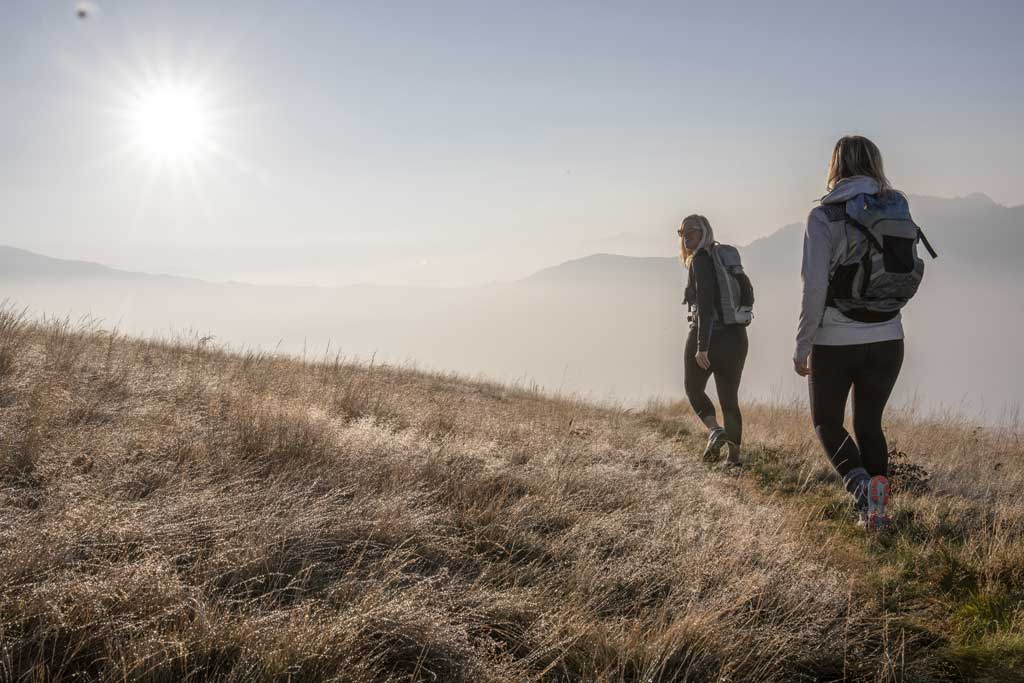5 ways to upgrade your walk

We already love walking. It’s the most popular exercise in England, with 18.6 million of us doing it regularly and 14.5 million using it as a form of transport. But many of us don’t see walking as a workout. ‘There’s a lot of pressure on women to be training like gladiators, but walking is brilliant for myriad reasons. And by increasing the intensity, you’ll really get your heart rate going, build strength and up fitness. At the same time, it has an incredibly low risk of injury,’ says Hannah Lewin.
Rather than seeing walking as a way to get from A to B, or as a lovely way to while away a Sunday afternoon, treat it as a workout. The best thing you can do is mix things up, altering pace, terrain and gradient, and throwing in extra tools and tricks. You’ll see a greater impact on your fitness, and you’ll target more muscle groups. Here’s how to do it.
1 Play with pace
Recent research from Japan saw people achieve a significant increase in fitness when they tried interval walking training. This involved walking at 70% of their maximum capacity for 3 minutes, then at 40% for the next 3 minutes. Then they repeated this for five sets. After five months, study subjects increased their VO2peak by 14%. This is a measure of fitness, indicating the highest amount of oxygen the body can use during exercise. ‘It’s tempting to think you get fitter by walking the same distance but quicker, but varying speed is better,’ says Lewin.
‘Over time, you can increase your intervals. So you might walk quickly for 30 seconds, then up it to 45 seconds. You can also increase the length of time you walk for. So you might go for 40 minutes and build up to an hour. You have two variables: the length of your intervals, and the length of time you spend walking.’
When it comes to the speedy section, you shouldn’t be able to hold a conversation. ‘If you’re not feeling short of breath, or feel your heart rate hasn’t increased, that’s a sign you need to pick up the pace,’ says Lewin. ‘You should be able to say “yes” or “no” but nothing more. And as you get fitter, you’ll have to work even harder.’
2 Change the terrain
We’ve all run on sand – it’s so hard to get anywhere that it can feel like we’ve doubled in weight. Well, the same principle works with walking. ‘Walking on trails, sand or grass all impact your body in different ways. They work your lower leg muscles differently, and require your upper body to stabilise over the different surfaces,’ says Lewin. ‘That can have a huge impact.’
Nordic walking, where you walk outdoors using poles, is another option. ‘The terrain is constantly changing so you’re getting the muscle imbalance that makes you work harder. You’re utilising your upper body by using the poles, and it’s a much more enjoyable way of walking.’
One of the best things you can do to turn your walk into a workout is incorporate hills. ‘They boost your metabolism, and build more strength,’ says Lewin. ‘When we’re hill-walking or walking on an incline on a treadmill, our hamstrings, glutes and quads work that little bit more, but it’s still safe for joints.’
3 Use music
A lot of research has shown the impact using music can have on running. By choosing the right tracks, it can up endurance by as much as 15%. The benefits runners are reaping can also be applied to walkers. If you struggle to pace your intervals, or stick to them, you can make playlists to help. This is also useful if your walk isn’t blessed with stunning views. For interval walking, intersperse fast-paced music with slower-paced tunes. Look for around 128bpm for a pacy stride.
‘You can find interval walking playlists that have a slightly higher bpm mixed with a lower one, and you can make your own playlists designed to last the amount of time you want to be out,’ says Lewin. ‘If you don’t like to exercise to music but you need a bit of entertainment for a boring walk, podcasts are great. I always run with Casefile, a true crime podcast. It’s a fantastic distraction.’
4 Add resistance
‘Ankle and wrist weights are a bit outdated now, but the idea of walking with weights is still an effective strategy,’ says Lewin. ‘Think about carrying a backpack with some weight. Use one designed for running or hiking, so it isn’t putting too much pressure or demand on your back. Or carry small dumbbells to build strength in your upper body.’
Doing a resistance workout on non-walking days is a great idea, too. ‘You’ll be using glutes, hamstrings and quads when you walk, particularly when you’re going uphill, so targeting those muscle groups with things like squats, lunges and glute bridges will make you a stronger walker.’
You need to think about your core, too. ‘Lots of people think the core is just your stomach, but it’s also your back. Think about the corset effect, with your deepest stomach muscles and your lower back,’ says Lewin. ‘Pilates is a fantastic option.’
5 Push into a jog!
You don’t need to become a full-blown runner, but building some jogging sections into a walk can be a major boost. ‘I would encourage people to introduce jogging in intervals. Replace the quicker walking interval with a jog, then rest by walking at a good pace,’ says Lewin. ‘As you get fitter, look at bringing your walk to a fast walk, and your jog to more of a run. It’s called progressive overload, so over time you’re increasing intensity.’
And there’s more than one way to achieve progressive overload. ‘You can also do it by decreasing rest time, so you work for longer than you’re resting. People often think the only way to get fitter is to exercise faster or for longer, but decreasing rest time is key. This is because you’re putting in the same amount of work, but in less time.’







